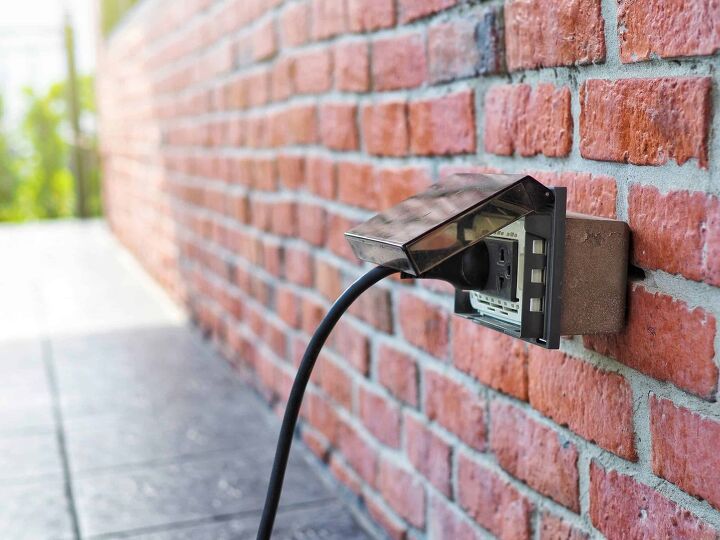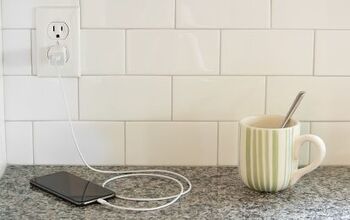How High Should An Outdoor Electrical Outlet Be?

As outdoor electrical outlets are subjected to different weather patterns, installing them falls under strict building codes.
The required height an outdoor electrical outlet must be is a maximum of six feet and six inches above the ground. There is no minimum height required. It is also required to have all ground-fault circuit-interrupters (GFCI) protected for all outdoor receptacles. There must be a receptacle required for decks, porches, and patios.
The biggest difference between outdoor wiring and interior wiring is the protections needed against water, weather, and dampness. For this reason, it is required by law to use GFCI-protected outlets and boxes.
Before engaging in electrical work, check your local electrical codes and follow all safety requirements. Hiring a registered electrician will be the safest route and ensures that proper electrical codes are being followed.
Do You Need to Hire an Electrician?
Get free, zero-commitment quotes from pro contractors near you.

Outdoor Receptacle Locations
Outdoor electrical outlets, also referred to as outdoor receptacles, must be installed in a variety of locations. During home construction, there are requirements for how many outlets are needed along the exterior of your property.
Once these requirements are met you have more leeway when it comes to the location and height of outdoor electrical outlets.
Along with installing outdoor electrical outlets on building structures, you can also have them installed on poles or posts within your yard. This will shorten the distance needed to run extension cords and is especially useful for pools and permanent patio structures.
All outdoor receptacles must be protected using a GFCI receptacle, GFCI breaker, and a weather-proofed security housing. These will protect your electrical outlets from the elements and reduce the risk of shock.
Required Outdoor Receptacles
There are a number of requirements for outdoor receptacles and you should check your local building codes to see if these requirements have been met.
- One outdoor receptacle is required at the front and rear of the house at a maximum of 6 ½ feet above grade.
- One outdoor receptacle is also required in the perimeter of each deck, porch, patio or balcony that is accessible from inside.
- A swimming pool must have access to an outdoor electrical outlet that is no closer than 6 feet and no further than 20 feet, from the closest edge of the pool. It must be no higher than 6 ½ feet above the pool deck and be GFCI protected.
- If the electrical outlet is used to power pump systems for a pool or spa, it must be no closer than 10 from the inside wall of the pool, spa, or hot tub. They must be single receptacles that serve no other appliance.
Requirements for Outdoor Lighting
Outdoor lighting is one of the most popular uses for outdoor electrical outlets. It allows for easy access to decorative and security lights, without needing to run extension cords into your house through open windows or doors.
There are electrical code requirements when it comes to lighting fixtures relating to outdoor electrical outlets. Check your local electrical codes if installing lighting-related outlets and fixtures.
- A lighting outlet is required at all garage egress doors, as well as on the exterior side of all exterior doors at grade level (first-floor doors).
- Light fixtures that are in wet, damp, or exposed areas must be listed for use in wet/damp areas. These offer built-in protections against water that are necessary to prevent electrocution.
- Outdoor light fixtures need to be rated for wet conditions and plugged into receptacles that are GFCI protected. For use of outdoor string lights, such as Christmas lights, it is important to use outdoor-rated bulbs and fixtures.
- Make sure any extension cords you are using are rated for outdoor use. These are covered in protective layers that won’t easily be damaged or degrade.
Outdoor Electrical Outlet Safety
Electrical boxes are durable enclosures that house the wire connections for your outdoor electrical outlet. They fulfill a range of needs and protections, safeguarding wires from dampness, rain, and animals.
- When installed outdoors, surface mounted boxes must be weather-resistant and have a weatherproof cover. This cover provides sealed protection from the elements when the cords are plugged into the receptacle.
- Outdoor electrical receptacles installed in damp locations must be approved for damp locations.
- Outdoor electrical receptacles located in areas unprotected from rainfall must have an in-use cover that is rated for wet locations.
- Metal boxes, whether indoors or outdoors, must be grounded to prevent electrocution.
All surface-mounted boxes must be listed for outdoor use and approved accordingly. Local codes may affect what types of electrical boxes can be used for certain applications. Contact your local inspector for more information.
Installing Outdoor Cables and Conduits
Standard NM cable has a vinyl outer jacket and waterproof insulation but is not intended for use in outdoor locations. Only use cables that are approved for outdoor use for maximum safety.
Circuit cables that are serving wall-mounted outdoor electrical outlets and light fixtures can be run through the wall and use standard nonmetallic cable. These are easier to install than running new lines from the pole or burying them underground.
Outdoor electrical outlets that are away from the house are usually run underground, for safety reasons.
Exposed or Buried Wire
Wiring and cable that is exposed or buried must be listed for its application. UF cable is the most commonly used cable for residential outdoor wiring applications.
- Cable that is in wet areas or underground must be UF-B type.
- UF Cable can be direct-buried without conduit, with a minimum of 24 inches of ground cover above it. Any exposed portions of UF cable must be protected by approved conduit.
- Wiring that is buried inside a rigid metal or intermediate conduit must have at least 6 inches of earth cover.
- Wiring in PVC conduit must have at least 18 inches of cover.
Always Call Before Burying Wire
Call the national ‘Call Before You Dig’ hotline at 811. The hotline operator will notify all utility providers in your area who will send a representative to your property to mark their lines running beneath the ground.
This will help you from cutting into dangerous lines and putting yourself in harm’s way, as well as disrupting utilities.
You can use power equipment to dig no closer than 24 inches to marked lines and then a hand shovel if you need to get closer than that.
Do You Need to Hire an Electrician?
Get free, zero-commitment quotes from pro contractors near you.

Related Questions
Do Outdoor Outlets Need to be On Their Own Circuit?
While outdoor outlets are not required to be on a separate circuit, it can be very useful. When using outdoor outlets for things such as Christmas lights, it can be easier to flip a breaker in your house to turn them on and off rather than set a timer or go outside to plug and unplug them.
Does Outdoor Electrical Wire Need to be in a Conduit?
Usually, local codes require that outdoor wiring be protected by conduit in an instance where outdoor wiring is installed above the ground.If the wiring is buried, most codes allow for Type UF cable, which is covered by heavy plastic sheathing. If using wire with a thin thermoplastic insulation, it will need to be encased in conduit for maximum protection.
Do Outdoor Outlets Need 20 Amps?
15–amp receptacles are typical for household appliances, lamps, and other accessories. This would be able to accommodate outdoor lighting. A 20–amp receptacle is for heavy-duty appliances and power tools, electric mowers, trimmers, etc.
Related Guides

Sean Jarvis is an interior decorator, writer, and expert handyman. Well versed in everything home improvement, he is a savant at manipulating words and spaces and upgrading everything around him. Sean specializes in writing concise guides about appliance repair and installation, home and lifestyle, and other residential projects.
More by Sean Jarvis














![Finishing Basement Without Permit [Is It Really Illegal?]](https://cdn-fastly.upgradedhome.com/media/2023/07/31/9070078/finishing-basement-without-permit-is-it-really-illegal.jpg?size=350x220)












